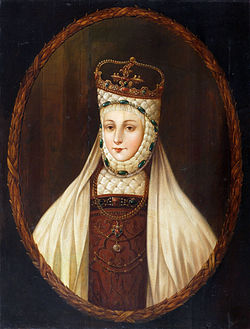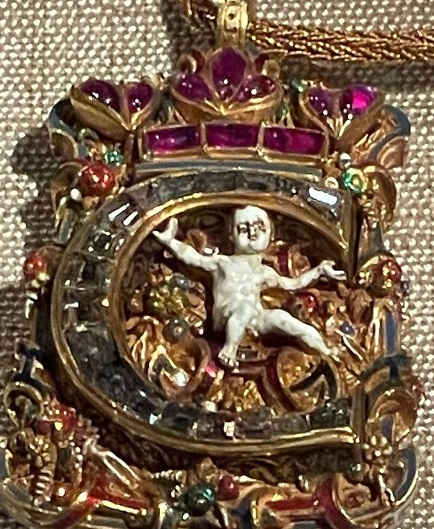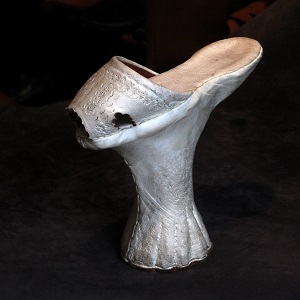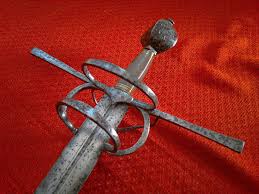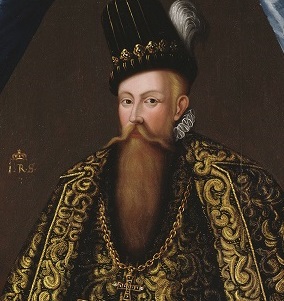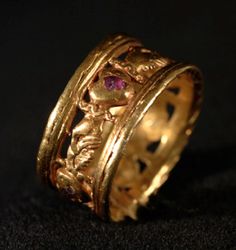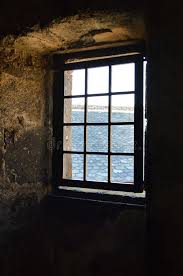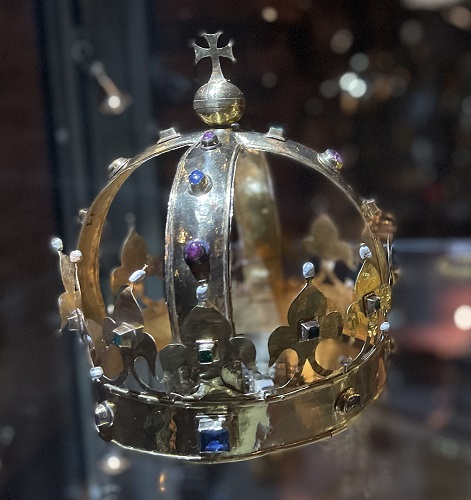The secrets of Catherine's tomb in Uppsala
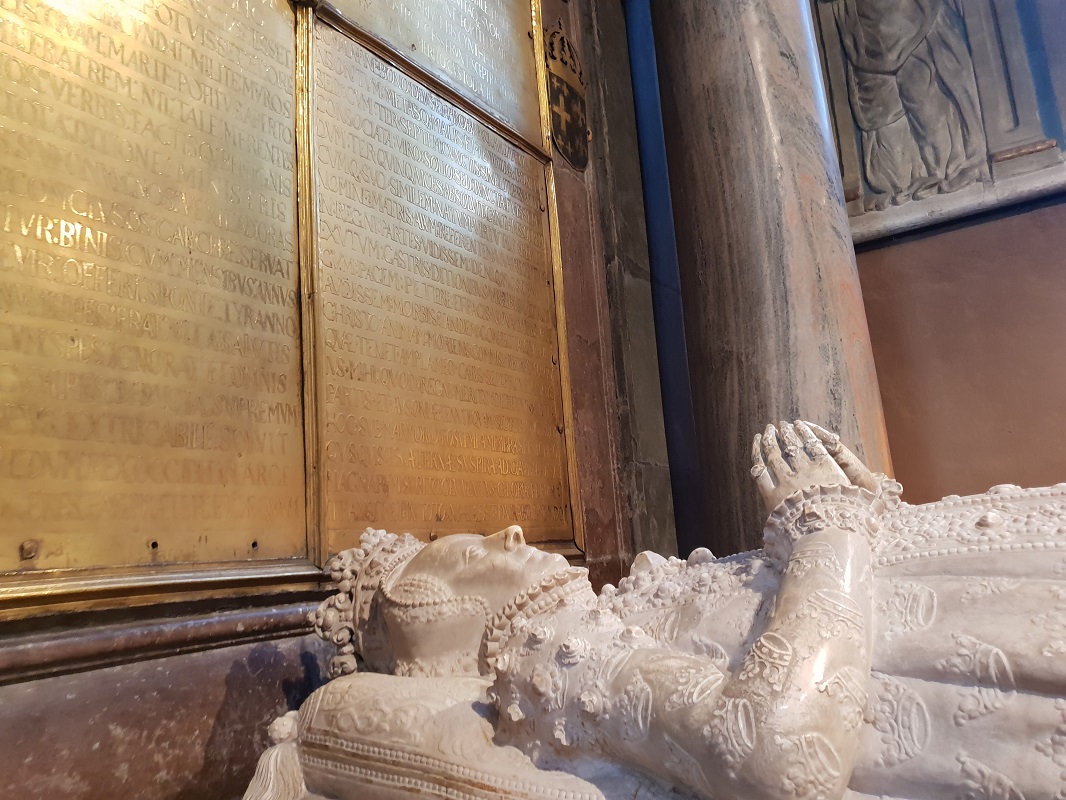
By Ilona Skujaitė
Source: 15 min.
Polish-Lithuanian Princess Catherine Jagiellon was Queen of Sweden for 14 years. After her death, she was buried in Uppsala alongside other Swedish royals. Her tomb offers a glimpse into the complex and often tragic lives of European royalty.
Crowned in life, entombed in death
On All Saints' Day, November 1, a date traditionally associated with remembrance of the departed, Catherine Jagiellon, the youngest daughter of the Lithuanian and Polish rulers King Sigismund the Old and Queen Bona Sforza, was born in Krakow in the year 1526.
It remains uncertain whether an astrological chart was created for the newborn princess, as was the case for her renowned brother Sigismund Augustus. However, Catherine's husband, King John III Vasa of Sweden, honored her memory by transforming her tomb into a stunning work of art.
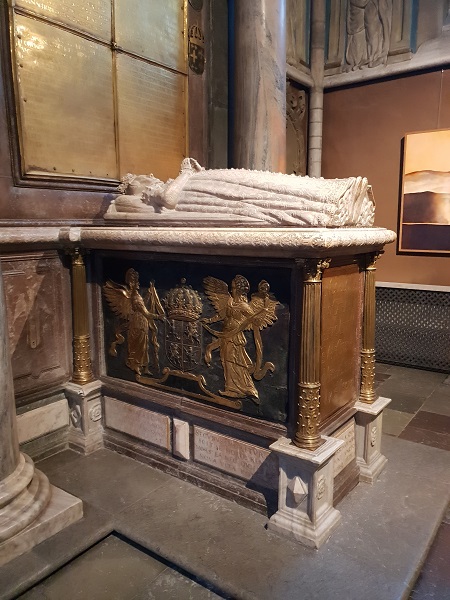
Catherine Jagiellon's monument in Uppsala Cathedral in Sweden.
In the nearly 700-year-old Uppsala Cathedral, there is a small chapel dedicated to Catherine Jagiellon and her husband Johan Vasa, distinguished by its splendor. As I traversed the Gothic vaults of the sanctuary, I was awestruck by the thought that she had once walked these very same hallowed halls. I envisioned Catherine, resplendent in a fur-trimmed mantle, proceeding towards the altar to be anointed and crowned Queen of Sweden.
As a pious Catholic, she likely offered prayers to her father-in-law, King Gustav Vasa of Sweden, and to the memorial of his first two wives. The third wife, Katarina Stenbock, was not commemorated in the same manner, possibly due to her exceptional longevity.

A fragment of the monument to the Swedish king Gustav Vasa in Uppsala Cathedral.
It is possible that Catherine Jagiellon witnessed the relics of St. Eric, the patron saint of Sweden, enshrined within a bejeweled gold coffin. As Annika, our knowledgeable guide, explained, the cathedral previously contained a vast collection of Catholic relics, many of which were discarded during the Reformation. However, the relics of St. Eric were preserved. King John III Vasa, facing financial difficulties, melted down the saint's original sarcophagus but commissioned a new, ornate golden coffin. Catherine Jagiellon is believed to have contributed to the addition of a magnificent crown above the saint's tomb, and a similar crown was later placed above her own.
A silent storyteller
I have examined numerous depictions of Catherine Jagiellon's ornate Renaissance tomb, sculpted by the esteemed artist Willam Boy. However, a mere description fails to capture the true magnificence of this artistic masterpiece.
As I approached the tomb, a sense of grief washed over me. I felt as though I were attending a funeral, about to confront the lifeless image of a beloved figure. Perhaps the sculptor captured her eternal slumber, her form forever frozen in the moment of death, a queenly figure, serene and still.
The monument is a testament to Catherine's royal status, adorned with crowns and coats of arms, including the Lithuanian Vytis, the Polish eagle, and the Swedish triple crown. The snake from her mother's Bona Sforza's coat of arms is prominently displayed above.
The imposing monument features a sculpted likeness of Catherine, remarkably reminiscent of her youthful portrait by Lucas Cranach the Younger, which I utilized for the cover of War Bride. The level of detail and craftsmanship exhibited in the stonework is truly awe-inspiring. The delicate lace and miniature crowns, meticulously carved into the stone, are particularly remarkable. The tomb exudes a sense of warmth and tranquility, rather than the cold and foreboding atmosphere typically associated with cemeteries.
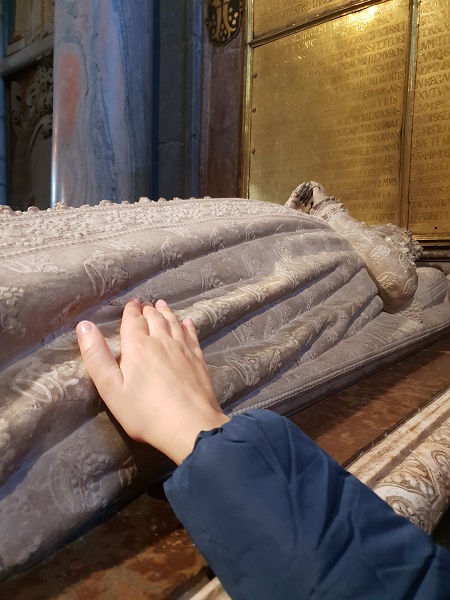 | 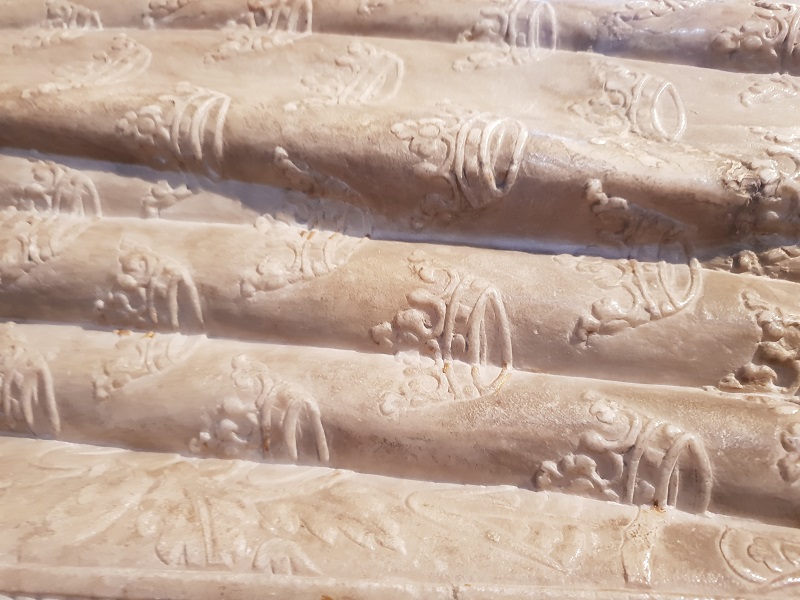 |
The author of the Catherine Jagiellon monument is William Boy, who recreated the queen's clothes in stone down to the smallest details.
Upon examining the Renaissance masterpiece, I pondered whether John III Vasa intended to immortalize his wife's likeness in stone, capturing her essence as realistically as possible. The Latin inscriptions on the monument provide a detailed account of Catherine Jagiellon's life, while a cryptic code etched into the table before the monument reveals the year of her demise, 1583.
A cosmic coincidence, a twist of fate. On this day, 440 years after her passing, I stood before her tomb, a pilgrim in time.
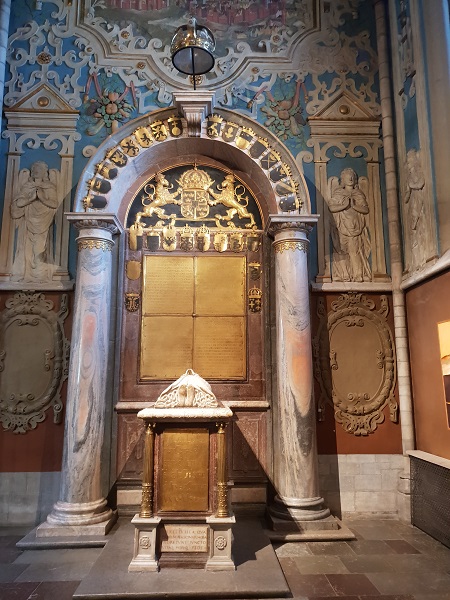 | 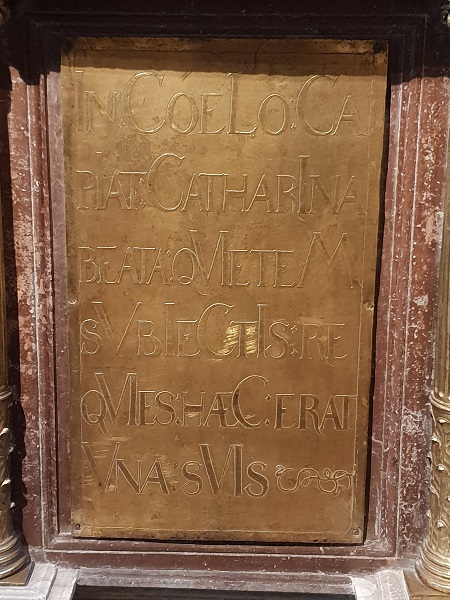 |
Latin inscriptions on the tombstone of Catherine Jagiellon.
The real grave
Although the pedestal of the sculpture may appear to be a sarcophagus containing the remains of Catherine Jagiellon, her actual burial site lies beneath the cathedral floor. Her burial site is marked by a heavy stone slab adorned with the coats of arms of the three kingdoms she was associated with. It is possible that Catherine Jagiellon considered it essential that her royal heritage be symbolized at her eternal resting place.
Annika, our guide, informed us that Catherine Jagiellon's tomb was opened approximately twenty years ago. Upon inspection, the interior of the tomb was found to be clean and well-preserved.
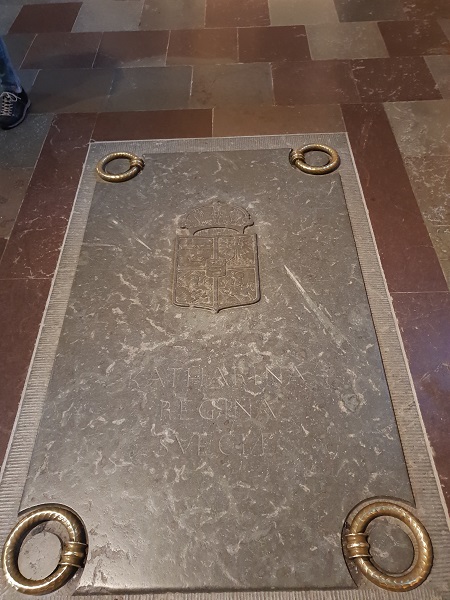 | 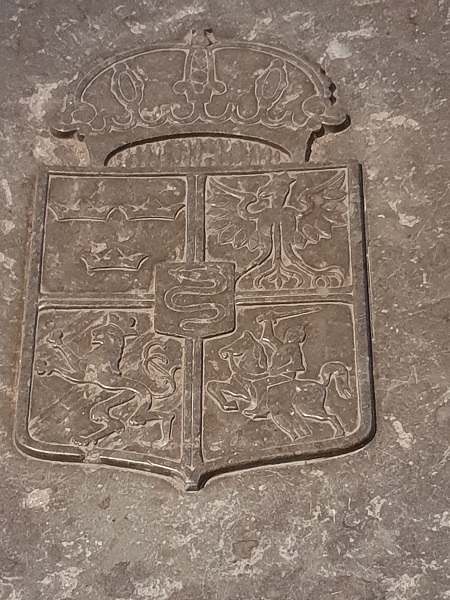 |
Catherine Jagiellon's eternal resting place under the floor of the Uppsala Cathedral is marked with the symbols of the coat of arms of the Swedish crown, the Lithuanian Vytis, the Polish eagle and the snake from her moter's Bona Sforza's sign.
Catherine Jagiellon's husband Johan III Vaza is buried with his second wife Gunilla Bielke also in Uppsala Cathedral, but in a different crypt. For a long time, Catherine's monument was alone in the chapel - an altar was installed in front of it, until a few hundred years later Johan unexpectedly returned to her. More precisely, here is his monument of impressive beauty, surrounded by heraldic signs and angels. It shows King John gracefully leaning on his arm as he gazes across the room at the monumen t of his wife.
The monument to John III Vasa was created in Gdansk but remained unfinished for nearly two centuries due to financial constraints and political turmoil. It was eventually brought to Uppsala Cathedral, where it found a suitable location in Catherine's chapel.

Monument of King Johan III Vasa of Sweden in Uppsala Cathedral.
In order to embellish the interior, stained glass windows were installed, bearing the personal mottos of the royal couple. John III Vasa's motto was "God is our savior," while Catherine Jagiellon's was the Latin phrase "Nemo nisi mors" (Nothing But Death). It was Catherine Jagiellon's enduring vow of love and loyalty to Johan III Vasa solemnized in Vilnius Cathedral. She remained steadfast in her devotion, even during his imprisonment in Gripsholm Castle, choosing to share his adversity and raise their children in poverty and hardship.
Nearly 500 years later, the stone effigies of Catherine and John lie side by side in Uppsala Cathedral, eternally united in death.
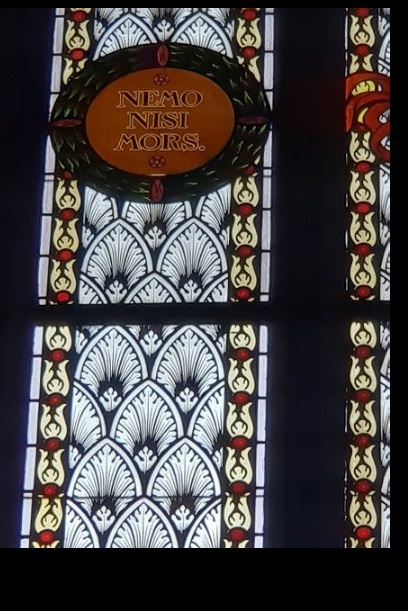
Secrets of coffins
Sweden's prolonged period of peace over the past five centuries has resulted in the preservation of its historical sites, enabling visitors to witness firsthand artifacts and structures described in ancient chronicles.
The posthumous regalia, including the crowns and scepters of Catherine and John, are exhibited in Uppsala Cathedral.
The pendant, adorned with the letter "C," was a cherished possession that accompanied Catherine Jagiellon throughout her life. It is probable that she desired to be interred with this sentimental item, which was founf in her coffin.
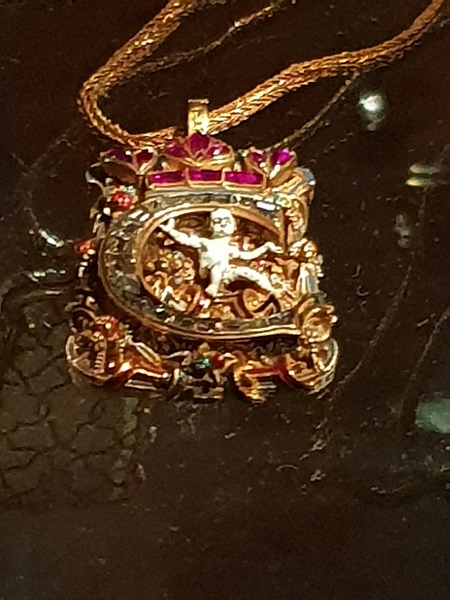 | 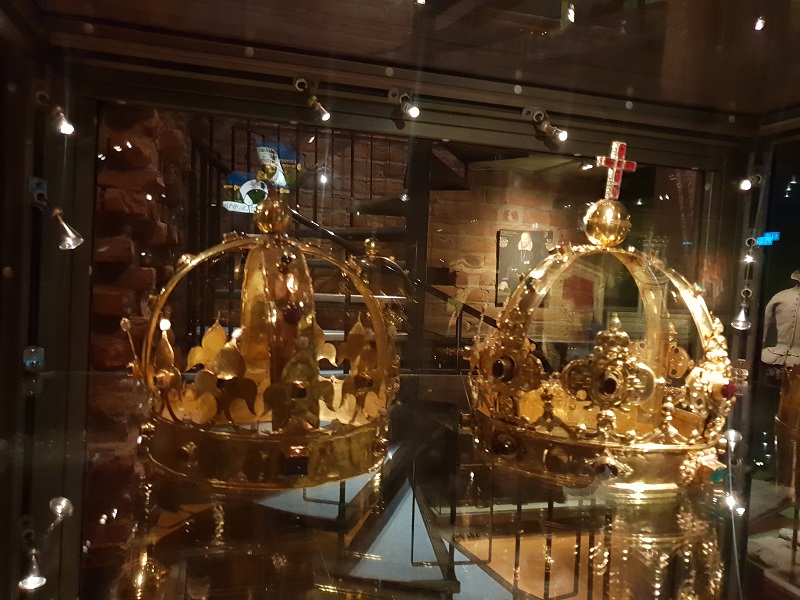 |
Catherine's and John's jewels were taken out of the coffin and exhibited in Uppsala Cathedral.
Posted on 2023-11-01


